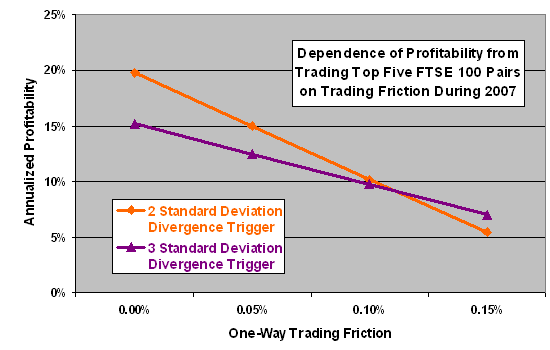What factors drive profitability for trading price divergences and convergences of pairs of similar stocks based on high-frequency data? In their March 2010 paper entitled “High Frequency Equity Pairs Trading: Transaction Costs, Speed of Execution and Patterns in Returns”, David Bowen, Mark Hutchinson and Niall O’Sullivan examine the characteristics of a high-frequency pairs trading strategy that takes a long (short) position in the relatively underpriced (overpriced) stock of a normally tracking pair upon divergence in price and closes positions upon convergence. They use overlapping 264-hour formation periods to identify the top five and top 20 trading pairs, followed by 132-hour trading periods for those pairs triggered by price divergence of two or three historical standard deviations. Using 60-minute return intervals calculated from tick by tick trade data for a sample of FTSE 100 stocks over calendar year 2007, they find that:
- A moderate 0.15% one-way trading friction generates average pair trading net profitability of less than half the gross profitability (see the chart below).
- Delaying trade execution by one 60-minute interval greatly reduces gross pair trading profitability and results in negative net profitability.
- Suggesting dependence on liquidity, pair trading profitability concentrates in:
- The first and last hours of trading (75% of profitability, mostly in the first hour).
- Monday (not statistically significant).
- July and August (sample is much too small for significance).
- Widely used risk factors (market, size, book-to-market, momentum and reversal) explain less than 2% of pair trading returns, with the weak explanatory power concentrated in the market and reversal factors.
The following chart, constructed from data in the paper, shows how the annualized average profitability of trading the top five FTSE 100 pairs during 2007 varies with one-way trading friction.

In summary, evidence indicates that success of high-frequency trading of paired stocks likely depends critically on minimizing trading friction, balancing trading friction and trigger sensitivity and reacting quickly to triggers, and perhaps on being especially alert during the first hour of trading.